Evaluating Solutions to Marine Plastic Pollution
Abstract
:1. Introduction
- What are the primary sources of publication and significant contributors to MPP research and control technologies?
- What scientific collaborations exist between countries in these research areas?
- What are the primary research topics in these fields?
- How do these research topics evolve?
- What are the distributions of these topics across countries and scientific journals?
2. Materials and Methods
2.1. Data Collection
2.2. Bibliometric Analysis
2.3. Latent Dirichlet Allocation
3. Results
4. Discussion
5. Conclusions
Author Contributions
Funding
Data Availability Statement
Conflicts of Interest
References
- Cózar, A.; Echevarría, F.; González-Gordillo, J.I.; Irigoien, X.; Úbeda, B.; Hernández-León, S.; Palma, Á.T.; Navarro, S.; García-de-Lomas, J.; Ruiz, A.; et al. Plastic debris in the open ocean. Proc. Natl. Acad. Sci. USA 2014, 111, 10239–10244. [Google Scholar] [CrossRef] [PubMed]
- Critchell, K.; Lambrechts, J. Modelling accumulation of marine plastics in the coastal zone; what are the dominant physical processes? Estuar. Coast. Shelf Sci. 2016, 171, 111–122. [Google Scholar] [CrossRef]
- Bošković, N.; Joksimović, D.; Peković, M.; Perošević-Bajčeta, A.; Bajt, O. Microplastics in surface sediments along the montenegrin coast, adriatic sea: Types, occurrence, and distribution. J. Mar. Sci. Eng. 2021, 9, 841. [Google Scholar] [CrossRef]
- de Lucia, G.A.; Vianello, A.; Camedda, A.; Vani, D.; Tomassetti, P.; Coppa, S.; Palazzo, L.; Amici, M.; Romanelli, G.; Zampetti, G.; et al. Sea water contamination in the Vicinity of the Italian minor islands caused by microplastic pollution. Water 2018, 10, 1108. [Google Scholar] [CrossRef]
- Dean, A.J.; Church, E.K.; Loder, J.; Fielding, K.S.; Wilson, K.A. How do marine and coastal citizen science experiences foster environmental engagement? J. Environ. Manag. 2018, 213, 409–416. [Google Scholar] [CrossRef]
- Chen, X.; Zhao, P.; Wang, D.; Wang, L.; Zhao, H.; Wang, X.; Zeng, Z.; Li, P.; Wang, T.; Liu, W.; et al. Microplastics in Marine Sediments in Eastern Guangdong in the South China Sea: Factors Influencing the Seasonal and Spatial Variations. Water 2023, 15, 1160. [Google Scholar] [CrossRef]
- Cheung, P.K.; Cheung, L.T.O.; Fok, L. Seasonal variation in the abundance of marine plastic debris in the estuary of a subtropical macro-scale drainage basin in South China. Sci. Total Environ. 2016, 562, 658–665. [Google Scholar] [CrossRef]
- Chubarenko, I.; Bagaev, A.; Zobkov, M.; Esiukova, E. On some physical and dynamical properties of microplastic particles in marine environment. Mar. Pollut. Bull. 2016, 108, 105–112. [Google Scholar] [CrossRef]
- Constant, M.; Kerhervé, P.; Mino-Vercellio-Verollet, M.; Dumontier, M.; Sànchez Vidal, A.; Canals, M.; Heussner, S. Beached microplastics in the Northwestern Mediterranean Sea. Mar. Pollut. Bull. 2019, 142, 263–273. [Google Scholar] [CrossRef]
- Convey, P.; Barnes, D.K.A.; Morton, A. Debris accumulation on oceanic island shores of the Scotia Arc, Antarctica. Polar Biol. 2022, 25, 612–617. [Google Scholar] [CrossRef]
- Eriksen, M.; Lebreton, L.C.M.; Carson, H.S.; Thiel, M.; Moore, C.J.; Borerro, J.C.; Galgani, F.; Ryan, P.G.; Reisser, J. Plastic Pollution in the World’s Oceans: More than 5 Trillion Plastic Pieces Weighing over 250,000 Tons Afloat at Sea. PLoS ONE 2014, 9, e111913. [Google Scholar] [CrossRef] [PubMed]
- Frère, L.; Paul-Pont, I.; Rinnert, E.; Petton, S.; Jaffré, J.; Bihannic, I.; Soudant, P.; Lambert, C.; Huvet, A. Influence of environmental and anthropogenic factors on the composition, concentration and spatial distribution of microplastics: A case study of the Bay of Brest (Brittany, France). Environ. Pollut. 2017, 225, 211–222. [Google Scholar] [CrossRef] [PubMed]
- Gajšt, T.; Bizjak, T.; Palatinus, A.; Liubartseva, S.; Kržan, A. Sea surface microplastics in Slovenian part of the Northern Adriatic. Mar. Pollut. Bull. 2016, 113, 392–399. [Google Scholar] [CrossRef]
- Gómez, V.; Pozo, K.; Nuñez, D.; Přibylová, P.; Audy, O.; Baini, M.; Fossi, M.C.; Klánová, J. Marine plastic debris in Central Chile: Characterization and abundance of macroplastics and burden of persistent organic pollutants (POPs). Mar. Pollut. Bull. 2020, 152, 110881. [Google Scholar] [CrossRef]
- Preston, B. Indirect Effects in Aquatic Ecotoxicology: Implications for Ecological Risk Assessment. Environ. Manag. 2002, 29, 311–323. [Google Scholar] [CrossRef] [PubMed]
- Miller, M.E.; Hamann, M.; Kroon, F.J. Bioaccumulation and biomagnification of microplastics in marine organisms: A review and meta-analysis of current data. PLoS ONE 2020, 15, e0240792. [Google Scholar] [CrossRef]
- Alava, J.J. Modeling the bioaccumulation and biomagnification potential of microplastics in a cetacean foodweb of the northeastern pacific: A prospective tool to assess the risk exposure to plastic particles. Front. Mar. Sci. 2020, 7, 566101. [Google Scholar] [CrossRef]
- Shruti, V.C.; Kutralam-Muniasamy, G.; Pérez-Guevara, F. Do microbial decomposers find micro- and nanoplastics to be harmful stressors in the aquatic environment? A systematic review of in vitro toxicological research. Sci. Total Environ. 2023, 903, 166561. [Google Scholar] [CrossRef]
- Benson, N.U.; Agboola, O.D.; Fred-Ahmadu, O.H.; De-la-Torre, G.E.; Oluwalana, A.; Williams, A.B. Micro (nano) plastics prevalence, food web interactions, and toxicity assessment in aquatic organisms: A review. Front. Mar. Sci. 2022, 9, 851281. [Google Scholar] [CrossRef]
- Wright, S.L.; Thompson, R.C.; Galloway, T.S. The physical impacts of microplastics on marine organisms: A review. Environ. Pollut. 2013, 178, 483–492. [Google Scholar] [CrossRef]
- Hidalgo-Ruz, V.; Honorato-Zimmer, D.; Gatta-Rosemary, M.; Nuñez, P.; Hinojosa, I.A.; Thiel, M. Spatio-temporal variation of anthropogenic marine debris on Chilean beaches. Mar. Pollut. Bull. 2018, 126, 516–524. [Google Scholar] [CrossRef]
- Hinata, H.; Sagawa, N.; Kataoka, T.; Takeoka, H. Numerical modeling of the beach process of marine plastics: A probabilistic and diagnostic approach with a particle tracking method. Mar. Pollut. Bull. 2020, 152, 110910. [Google Scholar] [CrossRef] [PubMed]
- Honorato-Zimmer, D.; Kruse, K.; Knickmeier, K.; Weinmann, A.; Hinojosa, I.A.; Thiel, M. Inter-hemispherical shoreline surveys of anthropogenic marine debris—A binational citizen science project with schoolchildren. Mar. Pollut. Bull. 2019, 138, 464–473. [Google Scholar] [CrossRef]
- Iwasaki, S.; Isobe, A.; Kako, S.; Uchida, K.; Tokai, T. Fate of microplastics and mesoplastics carried by surface currents and wind waves: A numerical model approach in the Sea of Japan. Mar. Pollut. Bull. 2017, 121, 85–96. [Google Scholar] [CrossRef] [PubMed]
- Rakib, M.R.J.; Ertaş, A.; Walker, T.R.; Rule, M.J.; Khandaker, M.U.; Idris, A.M. Macro marine litter survey of sandy beaches along the Cox’s Bazar Coast of Bay of Bengal, Bangladesh: Land-based sources of solid litter pollution. Mar. Pollut. Bull. 2022, 174, 113246. [Google Scholar] [CrossRef]
- Dereszewska, A.; Krasowska, K.; Popek, M. Microplastics in Harbour Seawaters: A Case Study in the Port of Gdynia, Baltic Sea. Sustainability 2023, 15, 6678. [Google Scholar] [CrossRef]
- Jambeck, J.R.; Geyer, R.; Wilcox, C.; Siegler, T.R.; Perryman, M.; Andrady, A.; Narayan, R.; Law, K.L. Plastic waste inputs from land into the ocean. Science 2015, 347, 768–771. [Google Scholar] [CrossRef]
- Kaliszewicz, A.; Panteleeva, N.; Karaban, K.; Runka, T.; Winczek, M.; Beck, E.; Poniatowska, A.; Olejniczak, I.; Boniecki, P.; Golovanova, E.V.; et al. First Evidence of Microplastic Occurrence in the Marine and Freshwater Environments in a Remote Polar Region of the Kola Peninsula and a Correlation with Human Presence. Biology 2023, 12, 259. [Google Scholar] [CrossRef]
- Keerthika, K.; Padmavathy, P.; Rani, V.; Jeyashakila, R.; Aanand, S.; Kutty, R. Spatial, seasonal and ecological risk assessment of microplastics in sediment and surface water along the Thoothukudi, south Tamil Nadu, south east India. Environ. Monit. Assess. 2022, 194, 820. [Google Scholar] [CrossRef]
- Cheung, P.K.; Fok, L. Evidence of microbeads from personal care product contaminating the sea. Mar. Pollut. Bull. 2016, 109, 582–585. [Google Scholar] [CrossRef]
- Li, J.; Gao, F.; Zhang, D.; Cao, W.; Zhao, C. Zonal Distribution Characteristics of Microplastics in the Southern Indian Ocean and the Influence of Ocean Current. J. Mar. Sci. Eng. 2022, 10, 290. [Google Scholar] [CrossRef]
- Liu, W.; Liao, H.; Wei, M.; Junaid, M.; Chen, G.; Wang, J. Biological uptake, distribution and toxicity of micro(nano)plastics in the aquatic biota: A special emphasis on size-dependent impacts. Trends Anal. Chem. 2024, 170, 117477. [Google Scholar] [CrossRef]
- Liubartseva, S.; Coppini, G.; Lecci, R.; Creti, S. Regional approach to modeling the transport of floating plastic debris in the Adriatic Sea. Mar. Pollut. Bull. 2016, 103, 115–127. [Google Scholar] [CrossRef]
- Locritani, M.; Merlino, S.; Abbate, M. Assessing the citizen science approach as tool to increase awareness on the marine litter problem. Mar. Pollut. Bull. 2019, 140, 320–329. [Google Scholar] [CrossRef]
- Maharana, D.; Saha, M.; Dar, J.Y.; Rathore, C.; Sreepada, R.A.; Xu, X.R.; Koongolla, J.B.; Li, H.X. Assessment of micro and macroplastics along the west coast of India: Abundance, distribution, polymer type and toxicity. Chemosphere 2020, 246, 125708. [Google Scholar] [CrossRef] [PubMed]
- Marrone, A.; La Russa, M.F.; Randazzo, L.; La Russa, D.; Cellini, E.; Pellegrino, D. Microplastics in the center of mediterranean: Comparison of the two calabrian coasts and distribution from coastal areas to the open sea. Int. J. Environ. Res. Public Health 2021, 18, 10712. [Google Scholar] [CrossRef] [PubMed]
- Monteiro, R.C.P.; Ivar do Sul, J.A.; Costa, M.F. Plastic pollution in islands of the Atlantic Ocean. Environ. Pollut. 2018, 238, 103–110. [Google Scholar] [CrossRef]
- Munari, C.; Corbau, C.; Simeoni, U.; Mistri, M. Marine litter on Mediterranean shores: Analysis of composition, spatial distribution and sources in north-western Adriatic beaches. Waste Manag. 2016, 49, 483–490. [Google Scholar] [CrossRef]
- Munari, C.; Scoponi, M.; Mistri, M. Plastic debris in the Mediterranean Sea: Types, occurrence and distribution along Adriatic shorelines. Waste Manag. 2017, 67, 385–391. [Google Scholar] [CrossRef]
- Neumann, D.; Callies, U.; Matthies, M. Marine litter ensemble transport simulations in the southern North Sea. Mar. Pollut. Bull. 2014, 86, 219–228. [Google Scholar] [CrossRef]
- Olivieri, Z.; Cesarini, G.; Orsini, M.; De Santis, S.; Scalici, M. Uptake of Microplastics in the Wedge Clam Donax trunculus: First Evidence from the Mediterranean Sea. Water 2022, 14, 4095. [Google Scholar] [CrossRef]
- Onink, V.; Jongedijk, C.E.; Hoffman, M.J.; van Sebille, E.; Laufkötter, C. Global simulations of marine plastic transport show plastic trapping in coastal zones. Environ. Res. Lett. 2021, 16, 064053. [Google Scholar] [CrossRef]
- Ourmieres, Y.; Mansui, J.; Molcard, A.; Galgani, F.; Poitou, I. The boundary current role on the transport and stranding of floating marine litter: The French Riviera case. Cont. Shelf Res. 2018, 155, 11–20. [Google Scholar] [CrossRef]
- Patidar, K.; Ambade, B.; Younis, A.M.; Alluhayb, A.H. Characteristics, fate, and sources of microplastics contaminant in surface water and sediments of river water. Phys. Chem. Earth 2024, 134, 103596. [Google Scholar] [CrossRef]
- Patti, T.B.; Fobert, E.K.; Reeves, S.E.; Burke da Silva, K. Spatial distribution of microplastics around an inhabited coral island in the Maldives, Indian Ocean. Sci. Total Environ. 2020, 748, 141263. [Google Scholar] [CrossRef]
- Phelan, A.A.; Ross, H.; Setianto, N.A.; Fielding, K.; Pradipta, L. Ocean plastic crisis—Mental models of plastic pollution from remote Indonesian coastal communities. PLoS ONE 2020, 15, e0236149. [Google Scholar] [CrossRef] [PubMed]
- Poeta, G.; Battisti, C.; Acosta, A.T.R. Marine litter in Mediterranean sandy littorals: Spatial distribution patterns along central Italy coastal dunes. Mar. Pollut. Bull. 2014, 89, 168–173. [Google Scholar] [CrossRef]
- Rangel-Buitrago, N.; Vergara-Cortés, H.; Barría-Herrera, J.; Contreras-López, M.; Agredano, R. Marine debris occurrence along Las Salinas beach, Viña Del Mar (Chile): Magnitudes, impacts and management. Ocean Coast. Manag. 2019, 178, 104842. [Google Scholar] [CrossRef]
- Rayon-Viña, F.; Miralles, L.; Gómez-Agenjo, M.; Dopico, E.; Garcia-Vazquez, E. Marine litter in south Bay of Biscay: Local differences in beach littering are associated with citizen perception and awareness. Mar. Pollut. Bull. 2018, 131, 727–735. [Google Scholar] [CrossRef]
- Cordova, M.R.; Nurhati, I.S. Major sources and monthly variations in the release of land-derived marine debris from the Greater Jakarta area, Indonesia. Sci. Rep. 2019, 9, 18730. [Google Scholar] [CrossRef]
- Ruiz-Orejón, L.F.; Sardá, R.; Ramis-Pujol, J. Floating plastic debris in the Central and Western Mediterranean Sea. Mar. Environ. Res. 2016, 120, 136–144. [Google Scholar] [CrossRef]
- Sana, S.S.; Dogiparthi, L.K.; Gangadhar, L.; Chakravorty, A.; Abhishek, N. Effects of microplastics and nanoplastics on marine environment and human health. Environ. Sci. Pollut. Res. 2020, 27, 44743–44756. [Google Scholar] [CrossRef] [PubMed]
- Schulz, M.; Krone, R.; Dederer, G.; Wätjen, K.; Matthies, M. Comparative analysis of time series of marine litter surveyed on beaches and the seafloor in the southeastern North Sea. Mar. Environ. Res. 2015, 106, 61–67. [Google Scholar] [CrossRef]
- Tashima, D.; Kashio, T.; Eguchi, T.; Kumagai, S.; Tsubota, T.; Madden, J.D.W. Recycling marine plastic waste to energy storage devices. Mater. Lett. 2023, 18, 100193. [Google Scholar] [CrossRef]
- Van der Velde, T.; Milton, D.A.; Lawson, T.J.; Wilcox, C.; Lansdell, M.; Davis, G.; Perkins, G.; Hardesty, B.D. Comparison of marine debris data collected by researchers and citizen scientists: Is citizen science data worth the effort? Biol. Conserv. 2017, 208, 127–138. [Google Scholar] [CrossRef]
- Wayman, C.; Niemann, H. The fate of plastic in the ocean environment-a minireview. Environ. Sci. Process. Impacts 2021, 23, 198–212. [Google Scholar] [CrossRef] [PubMed]
- Williams, A.T.; Randerson, P.; Di Giacomo, C.; Anfuso, G.; Macias, A.; Perales, J.A. Distribution of beach litter along the coastline of Cádiz, Spain. Mar. Pollut. Bull. 2016, 107, 77–87. [Google Scholar] [CrossRef]
- Williams, A.T.; Rangel-Buitrago, N.G.; Anfuso, G.; Cervantes, O.; Botero, C.M. Litter impacts on scenery and tourism on the Colombian north Caribbean coast. Tour. Manag. 2016, 55, 209–224. [Google Scholar] [CrossRef]
- Turrell, W.R. A simple model of wind-blown tidal strandlines: How marine litter is deposited on a mid-latitude, macro-tidal shelf sea beach. Mar. Pollut. Bull. 2018, 137, 315–330. [Google Scholar] [CrossRef]
- Xu, L.; Cao, L.; Huang, W.; Liu, J.; Dou, S. Assessment of plastic pollution in the Bohai Sea: Abundance, distribution, morphological characteristics and chemical components. Environ. Pollut. 2021, 278, 116874. [Google Scholar] [CrossRef]
- Zhang, H. Transport of microplastics in coastal seas. Estuar. Coast. Shelf Sci. 2017, 199, 74–86. [Google Scholar] [CrossRef]
- Blei, D.; Ng, A.; Jordan, M. Latent Dirichlet Allocation. J. Mach. Learn. Res. 2003, 3, 993–1022. [Google Scholar]
- Fernández-Arias, P.; Antón-Sancho, Á.; Lampropoulos, G.; Vergara, D. Emerging Trends and Challenges in Pink Hydrogen Research. Energies 2024, 17, 2291. [Google Scholar] [CrossRef]
- Moher, D.; Liberati, A.; Tetzlaff, J.; Altman, D.G. Preferred reporting items for systematic reviews and meta-analyses: The PRISMA statement. BMJ 2009, 339, 332–336. [Google Scholar] [CrossRef]
- Pranckutė, R. Web o Science (WoS) and Scopus: The Titans of Bibliographic Information in Today’s Academic World. Publications 2021, 9, 12. [Google Scholar] [CrossRef]
- Chadegani, A.A.; Salehi, H.; Yunus, M.M.; Farhadi, H.; Fooladi, M.; Farhadi, M.; Ebrahim, N.A. A comparison between two main academic literature collections: Web of science and scopus databases. Asian Soc. Sci. 2013, 9, 5. [Google Scholar] [CrossRef]
- Aria, M.; Cuccurullo, C. bibliometrix: An R-tool for comprehensive science mapping analysis. J. Informetr. 2017, 11, 959–975. [Google Scholar] [CrossRef]
- Grün, B.; Hornik, K. Topicmodels: An R Package for Fitting Topic Models. J. Stat. Softw. 2011, 40, 1–30. [Google Scholar] [CrossRef]
- Wang, C.; Blei, D.M. Collaborative topic modeling for recommending scientific articles. In Proceedings of the ACM SIGKDD International Conference on Knowledge Discovery and Data Mining, San Diego, CA, USA, 21–24 August 2011; pp. 448–456. [Google Scholar] [CrossRef]
- Griffiths, T.L.; Steyvers, M. Finding scientific topics. Proc. Natl. Acad. Sci. USA 2004, 101, 5228–5235. [Google Scholar] [CrossRef]
- Porteous, I.; Newman, D.; Ihler, A.; Asuncion, A.; Smyth, P.; Welling, M. Fast collapsed gibbs sampling for latent dirichlet allocation. In Proceedings of the ACM SIGKDD International Conference on Knowledge Discovery and Data Mining, Las Vegas, NV, USA, 24–27 August 2008; pp. 569–577. [Google Scholar] [CrossRef]
- Asuncion, A.; Welling, M.; Smyth, P.; Teh, Y.W. On smoothing and inference for topic models. In Proceedings of the 25th Conference on Uncertainty in Artificial Intelligence, UAI 2009, Montreal, QC, Canada, 18–21 June 2009; pp. 27–34. [Google Scholar]
- De la Hoz-M, J.; Fernández-Gómez, M.J.; Mendes, S. LDAShiny: An R package for exploratory review of scientific literature based on a Bayesian probabilistic model and machine learning tools. Mathematics 2021, 9, 1671. [Google Scholar] [CrossRef]
- Blei, D.M.; Lafferty, J.D. Dynamic Topic Models. In Proceedings of the ICML’06: Proceedings of the 23rd International Conference on Machine Learning, ,Pittsburgh, PA, USA, 25–29 June 2006; pp. 113–120. [Google Scholar] [CrossRef]
- Geman, S.; Geman, D. Stochastic Relaxation, Gibbs Distributions, and the Bayesian Restoration of Images. IEEE Trans. Pattern Anal. Mach. Intell. 1984, PAMI-6, 721–741. [Google Scholar] [CrossRef] [PubMed]
- Röder, M.; Both, A.; Hinneburg, A. Exploring the space of topic coherence measures. In Proceedings of the WSDM 2015—8th ACM International Conference on Web Search and Data Mining, Shanghai, China, 2–6 February 2015; pp. 399–408. [Google Scholar] [CrossRef]
- Chang, J.; Boyd-Graber, J.; Gerrish, S.; Wang, C.; Blei, D.M. Reading tea leaves: How humans interpret topic models. In Proceedings of the Advances in Neural Information Processing Systems 22 (NIPS 2009), Vancouver, BC, Canada, 7–10 December 2009; pp. 288–296. [Google Scholar]
- Lau, J.H.; Grieser, K.; Newman, D.; Baldwin, T. Automatic labelling of topic models. In Proceedings of the ACL-HLT 2011—49th Annual Meeting of the Association for Computational Linguistics: Human Language Technologies, Portland, OR, USA, 19–24 June 2011; Association for Computational Linguistics: Portland, OR, USA; pp. 1536–1545. [Google Scholar]
- Xiong, H.; Cheng, Y.; Zhao, W.; Liu, J. Analyzing scientific research topics in manufacturing field using a topic model. Comput. Ind. Eng. 2019, 135, 333–347. [Google Scholar] [CrossRef]
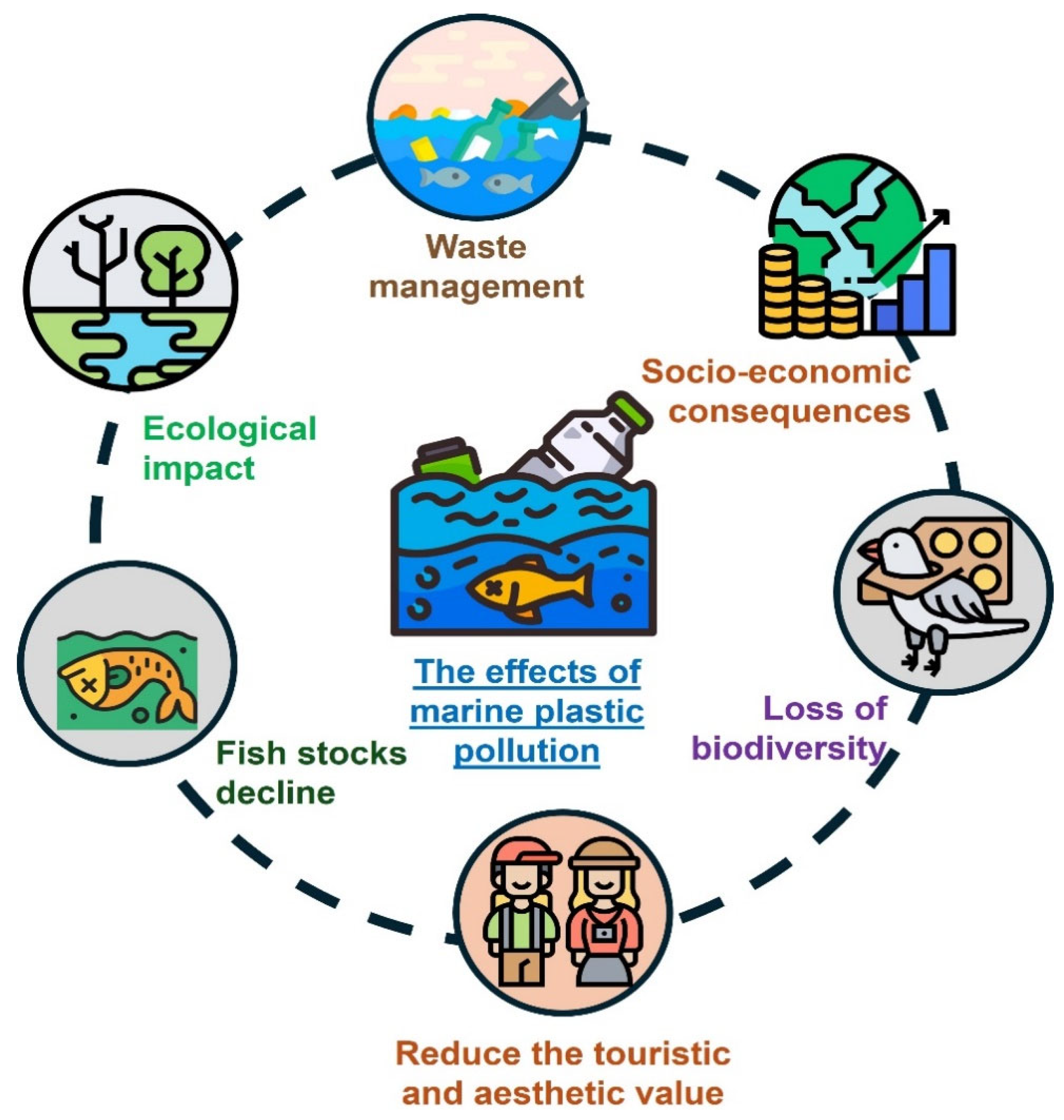



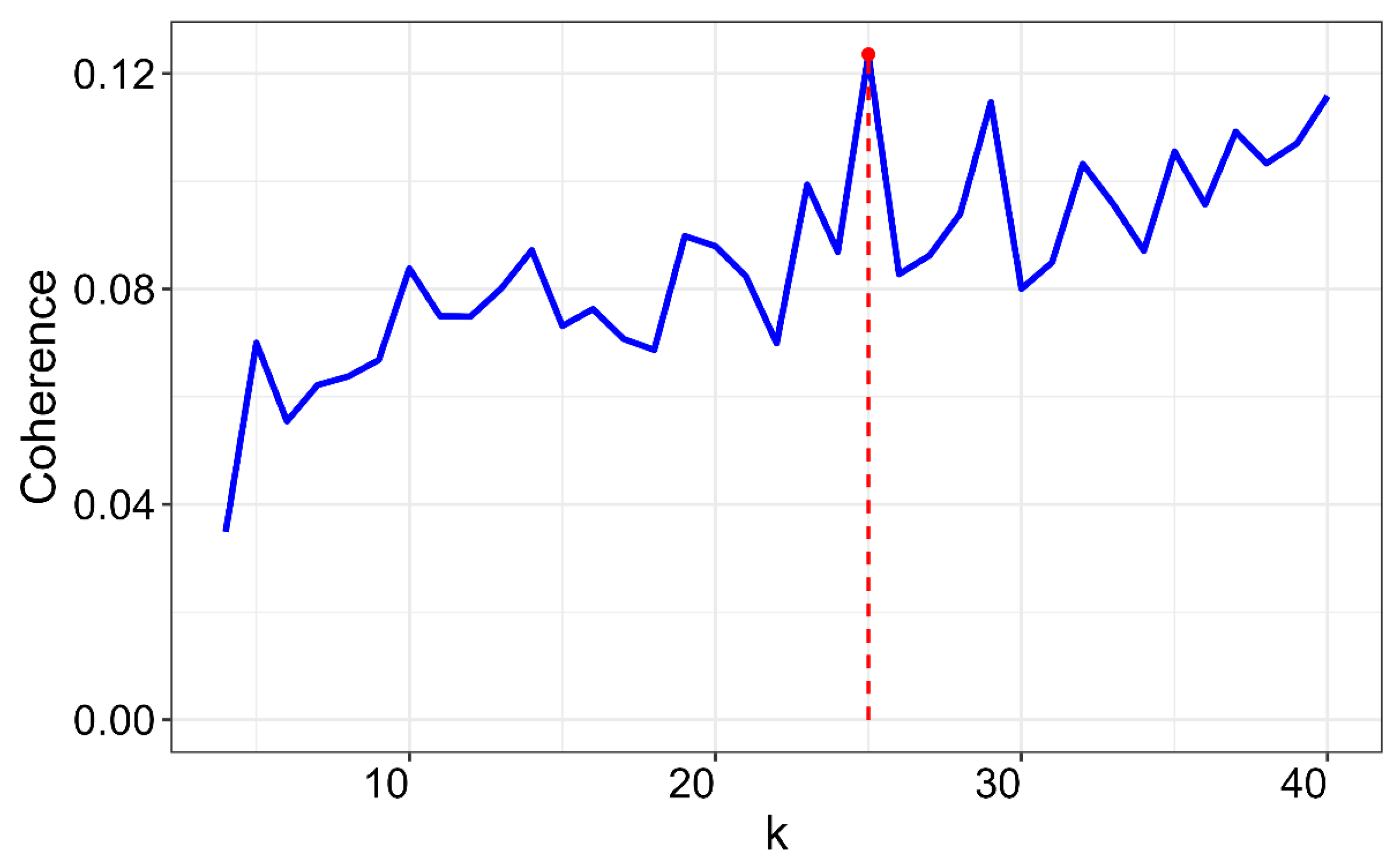
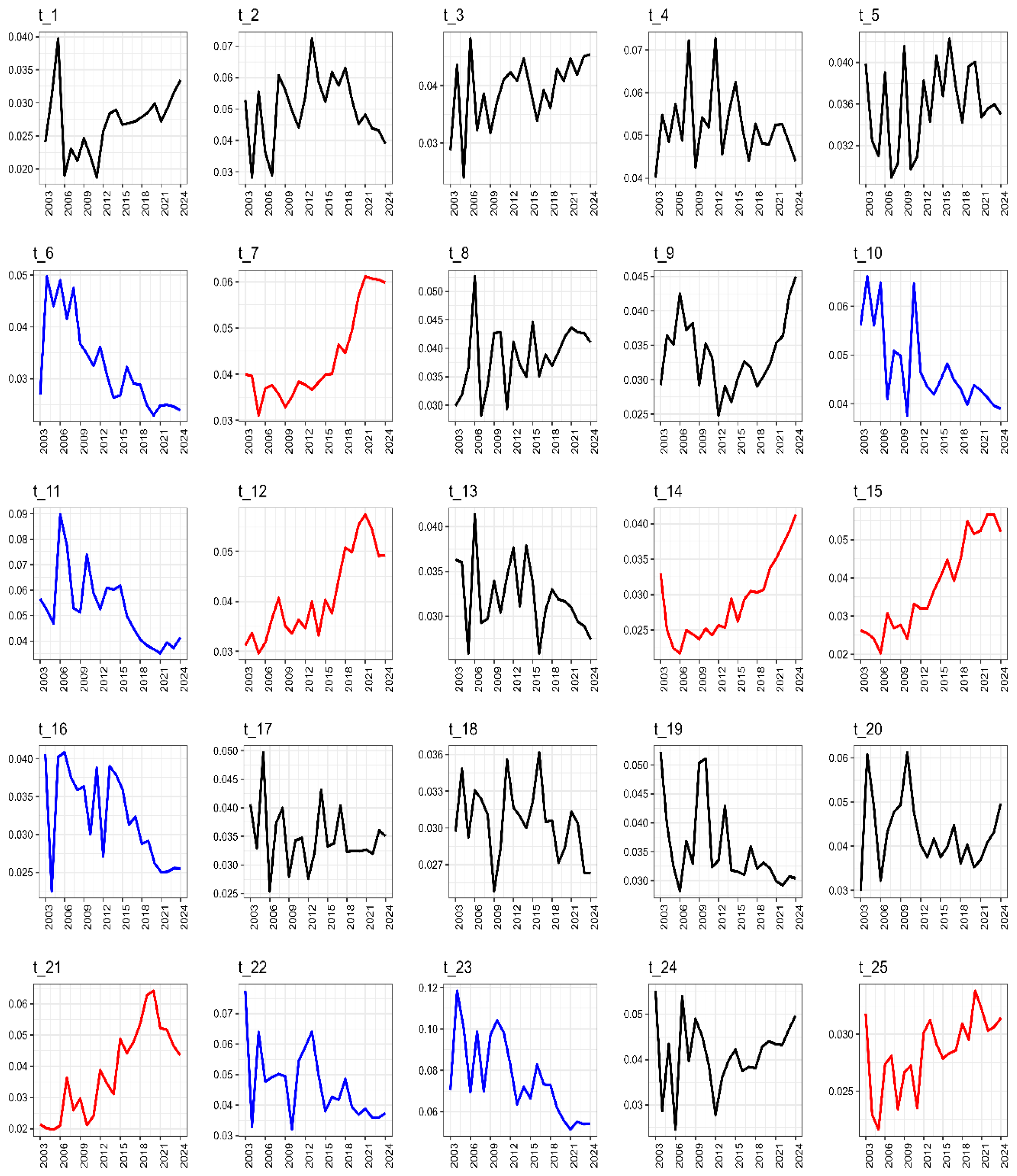
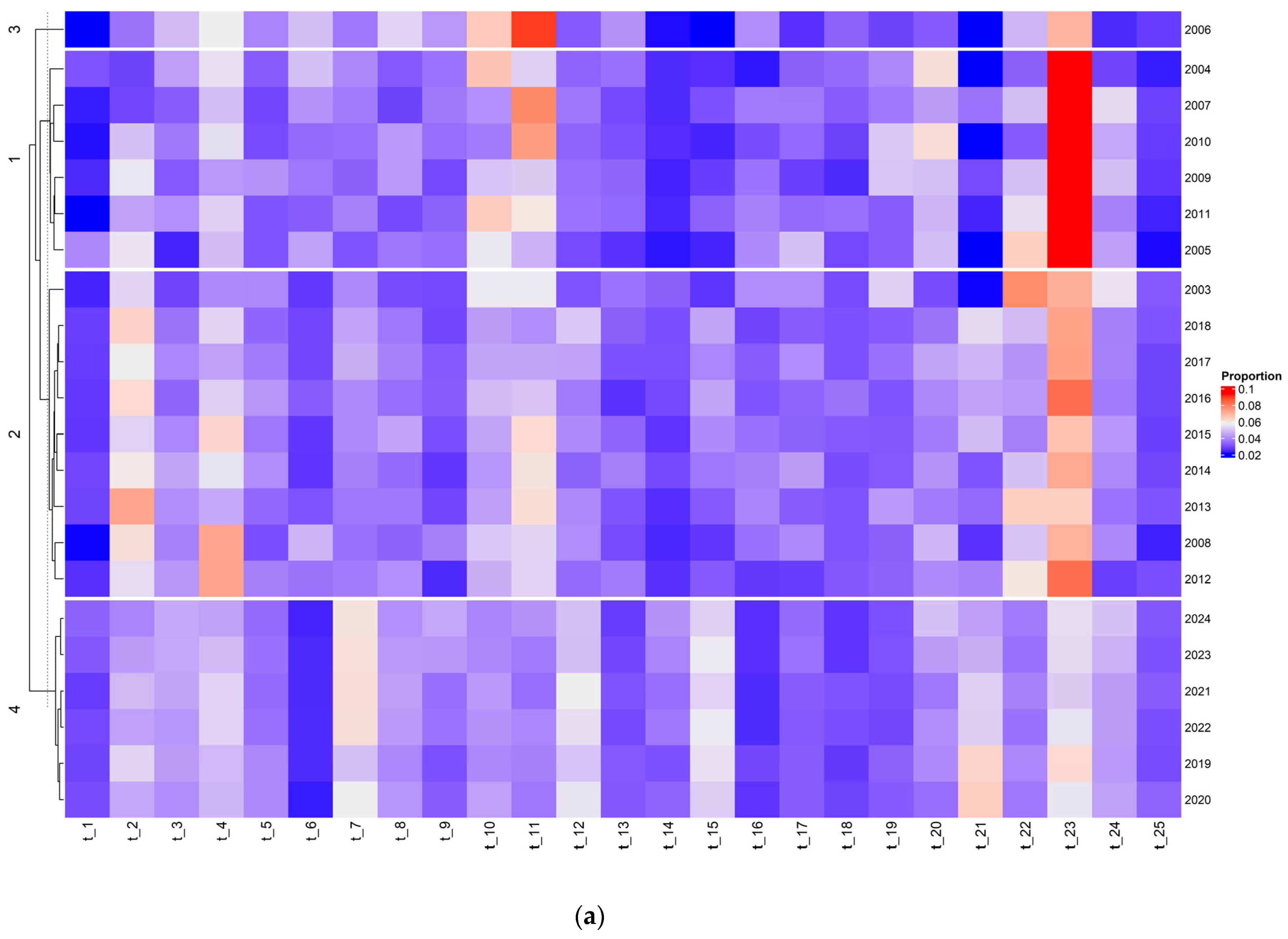
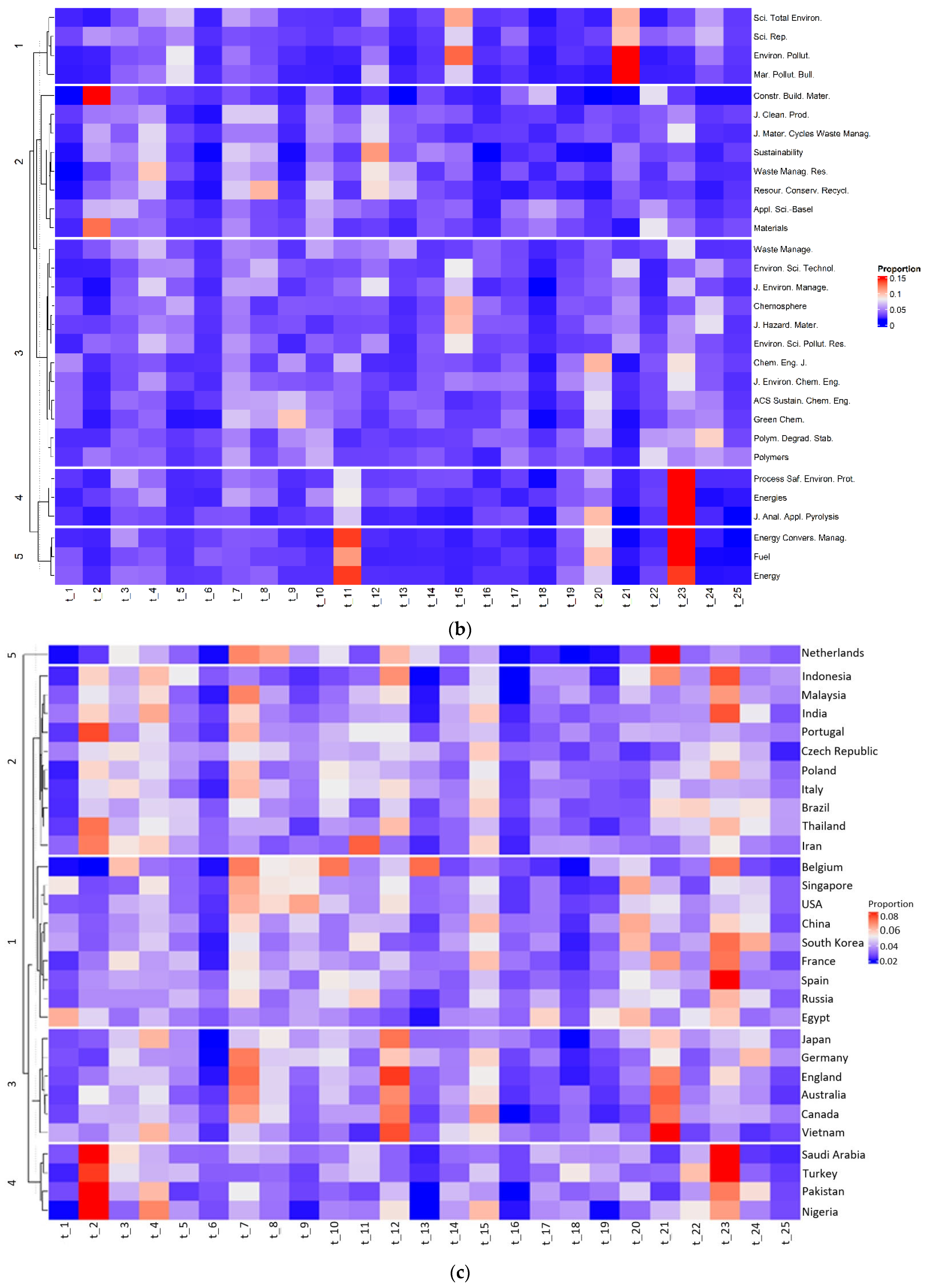
| Description | Results |
|---|---|
| Main information about data | |
| Timespan | 2003:2024 |
| Sources (Journals) | 1500 |
| Documents | 7772 |
| Annual Growth Rate % | 23.35 |
| Document Average Age | 3.06 |
| Average citations per doc | 30.33 |
| References | 264,300 |
| Document contents | |
| Keywords Plus (ID) | 9207 |
| Author’s Keywords (DE) | 15,779 |
| Authors | |
| Authors | 26,445 |
| Authors of single-authored docs | 239 |
| Authors collaboration | |
| Single-authored docs | 278 |
| Co-Authors per Doc | 5.04 |
| International co-authorships % | 30.53 |
| Document types | |
| Articles | 6640 |
| Reviews | 1132 |
| Source | H | TC | NP | PY_start |
|---|---|---|---|---|
| Science of the Total Environment | 57 | 13,508 | 265 | 2011 |
| Journal of Cleaner Production | 42 | 6123 | 212 | 2004 |
| Waste Management | 56 | 9974 | 207 | 2004 |
| Sustainability | 23 | 2076 | 199 | 2018 |
| Polymers | 25 | 2534 | 178 | 2014 |
| Marine Pollution Bulletin | 41 | 6312 | 162 | 2007 |
| Journal of Hazardous Materials | 37 | 4589 | 126 | 2003 |
| Construction and Building Materials | 43 | 5306 | 125 | 2008 |
| Environmental Science and Pollution Research | 25 | 2378 | 116 | 2003 |
| Environmental Pollution | 35 | 5090 | 109 | 2016 |
| Resources Conservation and Recycling | 43 | 5803 | 108 | 2006 |
| ACS Sustainable Chemistry & Engineering | 27 | 3454 | 107 | 2013 |
| Chemical Engineering Journal | 24 | 2339 | 97 | 2010 |
| Journal of Analytical and Applied Pyrolysis | 32 | 3451 | 95 | 2003 |
| Fuel | 26 | 2436 | 89 | 2003 |
| Journal of Environmental Management | 25 | 2268 | 78 | 2010 |
| Materials | 20 | 1446 | 78 | 2014 |
| Journal of Material Cycles and Waste Management | 15 | 819 | 72 | 2009 |
| Journal of Environmental Chemical Engineering | 18 | 1038 | 69 | 2017 |
| Energies | 15 | 642 | 64 | 2013 |
| Chemosphere | 24 | 2825 | 62 | 2006 |
| Process Safety and Environmental Protection | 19 | 1499 | 61 | 2016 |
| Energy | 22 | 1623 | 59 | 2011 |
| Green Chemistry | 20 | 2328 | 56 | 2015 |
| Energy Conversion and Management | 29 | 3287 | 55 | 2007 |
| Country | NP | TC |
|---|---|---|
| China | 1108 | 32,164 |
| India | 758 | 14,771 |
| USA | 600 | 35,441 |
| United Kingdom | 339 | 21,785 |
| Italy | 299 | 7353 |
| Spain | 289 | 8786 |
| South Korea | 278 | 6295 |
| Germany | 252 | 8506 |
| Australia | 201 | 5330 |
| Malaysia | 180 | 4691 |
| Brazil | 176 | 3353 |
| Japan | 169 | 2674 |
| Poland | 168 | 2599 |
| Indonesia | 150 | 1341 |
| Thailand | 133 | 1913 |
| Canada | 124 | 6764 |
| Iran | 122 | 2106 |
| France | 117 | 4111 |
| Saudi Arabia | 109 | 3322 |
| Pakistan | 106 | 3963 |
| T | N | Top_Terms | Label |
|---|---|---|---|
| t_1 | 170 | carbon, activ, perform, materi, deriv, exhibit, util, wast, effici, surfac, applic, fabric, graphen, straw, structur, capac, prepar, demonstr, synthes, devic | Carbon-Based Materials from Waste |
| t_2 | 542 | concret, strength, aggreg, wast, compress, replac, construct, increas, compress_strength, properti, mix, cement, fiber, sand, natur, investig, materi, decreas, flexur, test | Use of Plastic Waste in Concrete |
| t_3 | 285 | model, method, base, analysi, design, propos, data, develop, optim, predict, appli, techniqu, evalu, approach, determin, methodologi, network, identifi, time, set | Data-Driven Models for Plastic Waste |
| t_4 | 398 | wast, manag, gener, dispos, wast_manag, landfil, solid, solid_wast, wast_gener, increas, municip, mask, COVID, pandem, inciner, treatment, protect, msw, wast_dispos, household | Municipal Solid Waste Management |
| t_5 | 173 | sampl, water, particl, microplast, size, type, concentr, surfac, detect, rang, abund, observ, averag, distribut, sediment, investig, mp, fragment, studi, presenc | Microplastic Distribution in Water Bodies |
| t_6 | 40 | polyethylen, densiti, hdpe, ldpe, densiti_polyethylen, p, polypropylen, polystyren, polyethylen_hdpe, polyethylen_ldpe, type, polystyren_p, polyethylen_polypropylen, weight, polym, studi, blend, linear, mixtur, observ | Effects of Pyrolysis on Polyethylene |
| t_7 | 462 | review, product, technologi, circular, economi, develop, discuss, current, challeng, base, futur, circular_economi, strategi, includ, industri, approach, provid, advanc, highlight, resourc | Technological Innovations in Circular Economy |
| t_8 | 273 | impact, environment, life, assess, emiss, econom, cycl, cost, product, environment_impact, reduc, scenario, global, life_cycl, potenti, benefit, compar, reduct, analysi, consumpt | Life Cycle Assessment in Waste Management |
| t_9 | 274 | polym, chemic, upcycl, depolymer, monom, function, polymer, solvent, effici, demonstr, membran, bond, chain, poli, molecular, method, structur, promis, select, report | Chemical Recycling and Polymer Upcycling |
| t_10 | 244 | recycl, materi, wast, process, product, industri, mechan, post, manufactur, consum, recycl_wast, applic, wast_recycl, raw, post_consum, mechan_recycl, virgin, raw_materi, print, produc | Mechanical Recycling of Post-consumer Plastics |
| t_11 | 306 | energi, process, biomass, gasif, product, wast, effici, fuel, ga, increas, produc, ratio, hydrogen, heat, bed, combust, convers, feedstock, content, temperature | Waste-to-Energy Conversion via Gasification |
| t_12 | 464 | polici, reduc, manag, countri, consum, behavior, consumpt, implement, level, practic, factor, public, respons, environment, chang, govern, bag, social, singl, find | Consumer Behavior and Plastic Reduction Policies |
| t_13 | 98 | wast, separ, recoveri, sort, rate, collect, stream, mix, recycl, process, plant, chain, close, packag, achiev, wast_stream, qualiti, improv, flow, suppli | Plastic Waste Recovery Systems |
| t_14 | 44 | environment, sustain, solut, develop, wast, issu, friendli, green, effect, cost, approach, concern, util, address, eco, altern, challeng, potenti, environment_friendli, contribut | Environmental Sustainability and Eco-solutions |
| t_15 | 562 | environ, microplast, pollut, mp, human, effect, organ, health, contamin, risk, potenti, ecosystem, impact, soil, exposur, aquat, environment, human_health, toxic, increas | Microplastic Impact on Ecosystems and Health |
| t_16 | 113 | pvc, treatment, metal, concentr, chlorid, compound, oxid, addit, polyvinyl, organ, pc, chlorin, polyvinyl_chlorid, electron, extract, light, separ, electr, chemic, heavi | Chemical Treatment of PVC and Metal Waste |
| t_17 | 223 | pet, terephthal, polyethylen, polyethylen_terephthal, bottl, terephthal_pet, spectroscopi, electron, analysi, transform, scan, ftir, infrar, character, sem, microscopi, pet_wast, fourier, ethylen, surfac | PET and Plastic Degradation Processes |
| t_18 | 167 | test, perform, mixtur, modifi, asphalt, mix, addit, improv, soil, wast, increas, binder, ag, resist, bitumen, content, stabil, evalu, term, properti | Asphalt Modification with Plastic Waste |
| t_19 | 196 | rate, activ, kinet, adsorpt, process, p, remov, reaction, mass, model, mol, paramet, method, investig, adsorb, interact, energi, polystyren, analysi, activ_energi | Adsorption Processes for Pollutant Removal |
| t_20 | 411 | catalyst, catalyt, product, reaction, acid, yield, select, activ, convers, hydrogen, crack, format, aromat, zeolit, catalyt_pyrolysi, oxid, metal, valuabl, promot, chemic | Catalytic Processes in Waste Conversion |
| t_21 | 549 | marin, pollut, ocean, sourc, debri, litter, global, river, fish, sea, region, transport, speci, marin_pollut, beach, data, major, item, coastal, estim | Marine Pollution and Oceanic Waste Transport |
| t_22 | 294 | properti, composit, mechan, thermal, blend, addit, improv, fiber, increas, mechan_properti, strength, tensil, physic, polym, matrix, materi, compar, reinforc, applic, fibr | Mechanical Properties of Polymer-Reinforced Composites |
| t_23 | 727 | pyrolysi, oil, degre, temperatur, product, fuel, yield, liquid, ga, time, fraction, thermal, produc, increas, rang, reactor, diesel, process, hydrocarbon, heat | Fuel Production from Plastic Waste via Pyrolysis |
| t_24 | 568 | degrad, biodegrad, pla, enzym, microbi, polym, strain, acid, synthet, isol, microorgan, environ, cell, weight, potenti, bacteri, condit, dai, pha, accumul | Biodegradation of Polymers in Natural Environments |
| t_25 | 189 | film, packag, food, base, water, materi, biodegrad, bio, bioplast, particl, applic, agricultur, food_packag, coat, surfac, altern, barrier, cellulos, increas, packag_materi | Biodegradable Films in Packaging and Agriculture |
Disclaimer/Publisher’s Note: The statements, opinions and data contained in all publications are solely those of the individual author(s) and contributor(s) and not of MDPI and/or the editor(s). MDPI and/or the editor(s) disclaim responsibility for any injury to people or property resulting from any ideas, methods, instructions or products referred to in the content. |
© 2025 by the authors. Licensee MDPI, Basel, Switzerland. This article is an open access article distributed under the terms and conditions of the Creative Commons Attribution (CC BY) license (https://creativecommons.org/licenses/by/4.0/).
Share and Cite
Vergara, D.; de la Hoz-M, J.; Ariza-Echeverri, E.A.; Fernández-Arias, P.; Antón-Sancho, Á. Evaluating Solutions to Marine Plastic Pollution. Environments 2025, 12, 86. https://doi.org/10.3390/environments12030086
Vergara D, de la Hoz-M J, Ariza-Echeverri EA, Fernández-Arias P, Antón-Sancho Á. Evaluating Solutions to Marine Plastic Pollution. Environments. 2025; 12(3):86. https://doi.org/10.3390/environments12030086
Chicago/Turabian StyleVergara, Diego, Javier de la Hoz-M, Edwan Anderson Ariza-Echeverri, Pablo Fernández-Arias, and Álvaro Antón-Sancho. 2025. "Evaluating Solutions to Marine Plastic Pollution" Environments 12, no. 3: 86. https://doi.org/10.3390/environments12030086
APA StyleVergara, D., de la Hoz-M, J., Ariza-Echeverri, E. A., Fernández-Arias, P., & Antón-Sancho, Á. (2025). Evaluating Solutions to Marine Plastic Pollution. Environments, 12(3), 86. https://doi.org/10.3390/environments12030086









